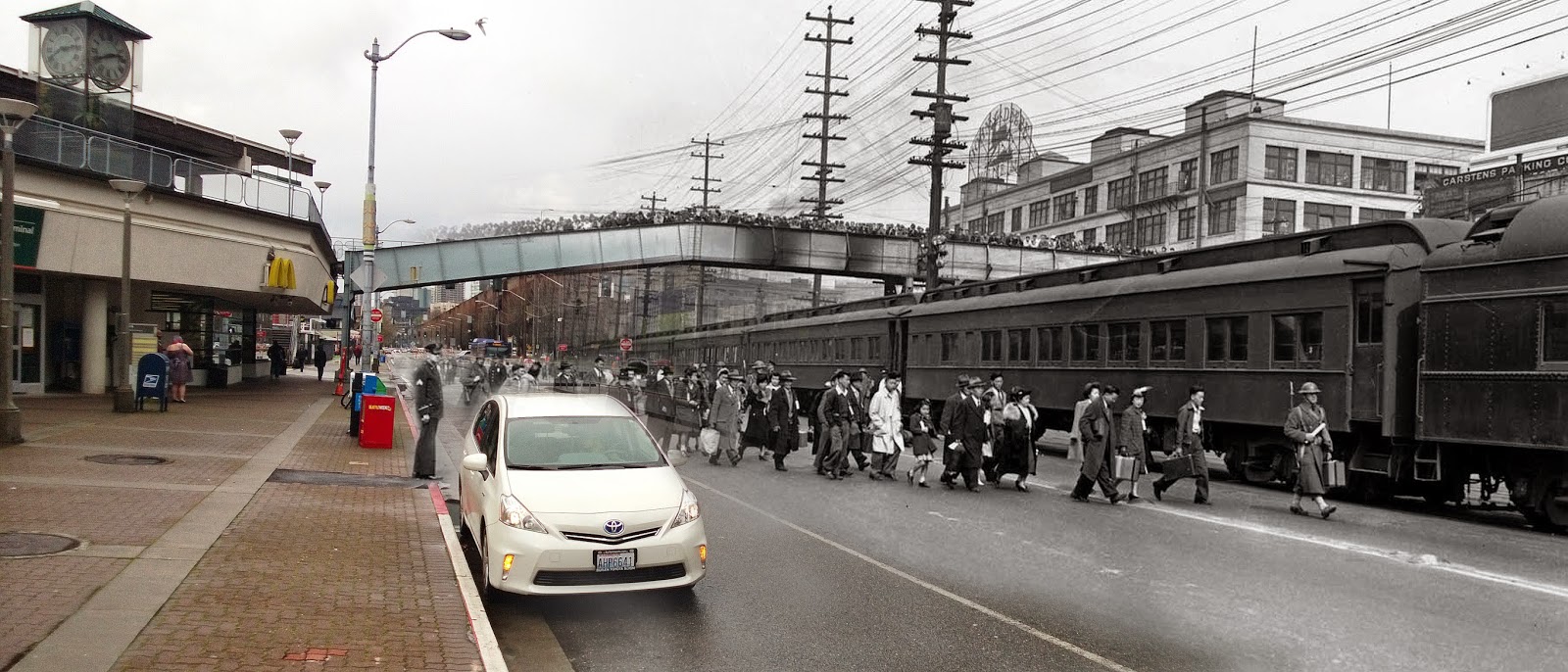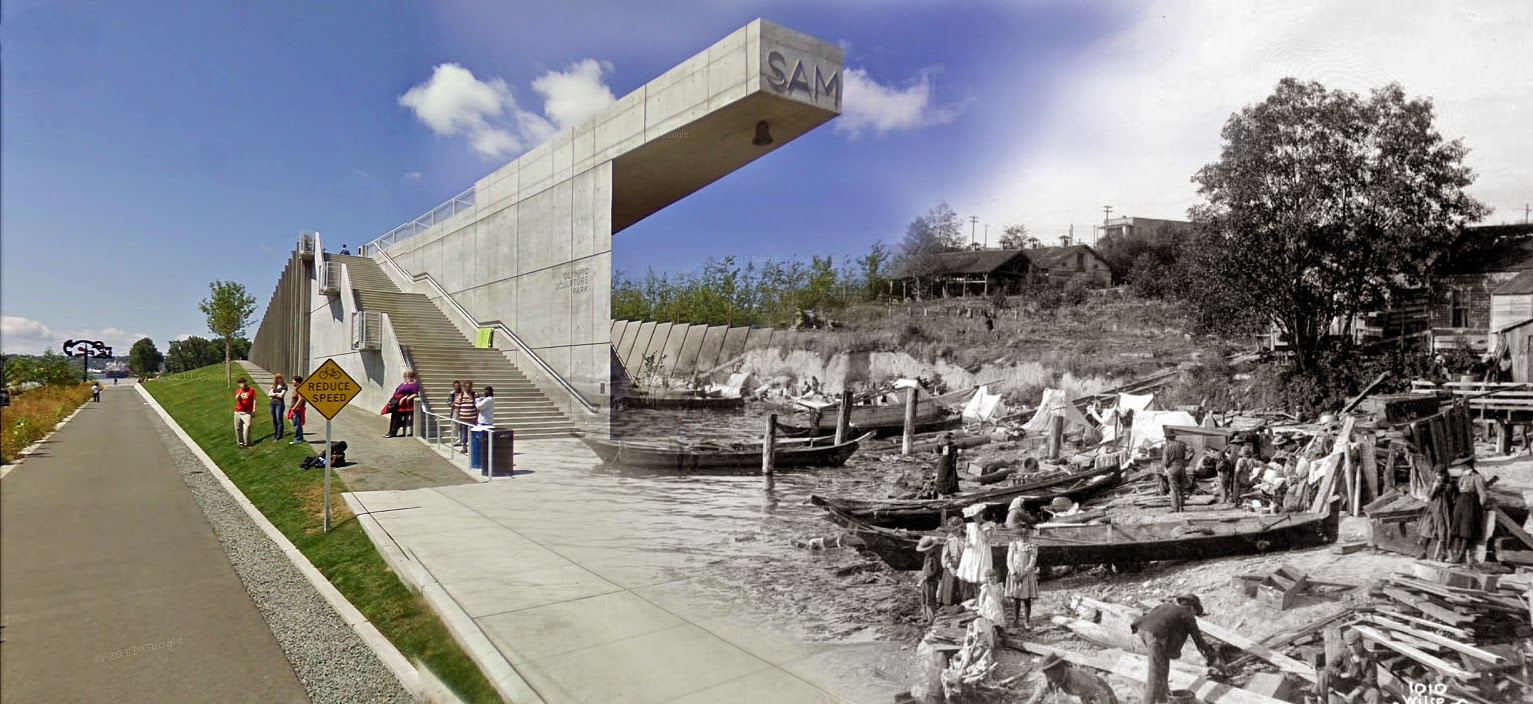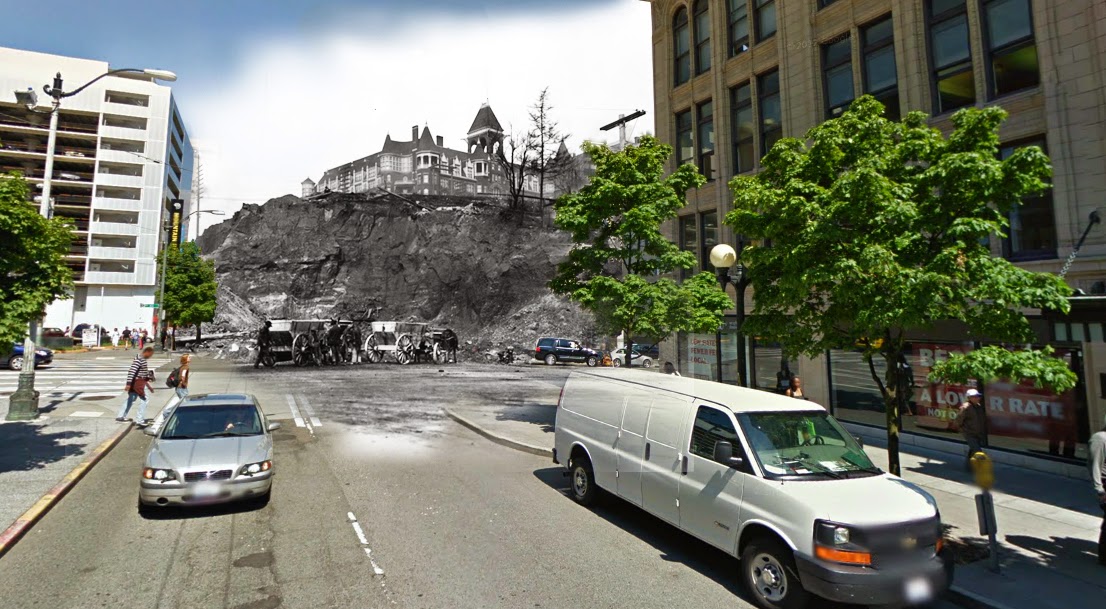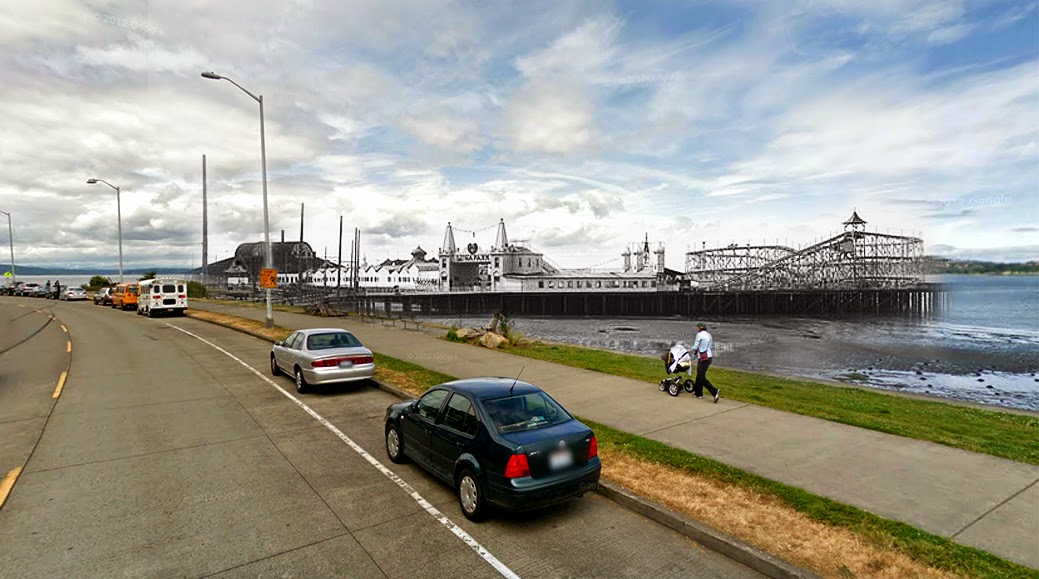If Seattle’s streets could talk, they’re likely to tell you the stories depicted in Clayton Kauzlaric’s photos.
Kauzlaric uses Photoshop to juxtapose archival photos with present-day images of the same location.
Take, for instance, the stretch of Alaskan Way that houses the ferry terminal on Seattle’s waterfront. These days, it’s an unremarkable place where a McDonald’s sign greets passersby. But it has quite a history — it’s also the same place Japanese residents were made to board trains headed to internment camps back in 1942.
3
To help transport contemporaries to that historic point in time, Kauzlaric aligned the current landscape with an archival image of the internees’ somber march.
“The image of the internees crossing Alaskan Way is hard to believe,” Kauzlaric said. “Can you imagine any of us leaving our homes with a day’s notice?”

“Japanese residents boarding a train during their forced relocation to internment camps in 1942. This was shot in front of the ferry terminal on Alaskan Way. It looks like the Marion Street pedestrian bridge is packed with spectators.” (Courtesy of Clayton Kauzlaric)
Since he began the “Then & Again” project a year ago, Kauzlaric has completed some 30 images so far. One depicts the city’s Depression-era Hooverville, which housed some 1,000 residents at its peak, on the Seattle waterfront, just across the Alaskan Way viaduct from CenturyLink.
“The fact it’s gigantic and that it lingered for a decade is hard to imagine today,” Kauzlaric said.
Another image shows the creation of the Denny Regrade, which involved flattening Denny Hill by sluicing it into the water in 1897. Others illustrate the aftermath of the Great Fire of 1889, which started with a cabinetmaker’s boiling pot of glue and destroyed 25 city blocks of what would later become Pioneer Square.
1
!["A before and after [of the regrade] at 6th and Marion with buildings from 1914." (Courtesy of Clayton Kauzlaric)](http://www.quirksee.org/wp-content/uploads/2014/09/Seattle_6thMarion_1920_2012-1.jpg)
“A before and after [of the regrade] at 6th and Marion with buildings from 1914.” (Courtesy of Clayton Kauzlaric)

“The Occidental Hotel was a gorgeous building that stood where we find the ‘sinking ship’ parking garage today near Pioneer Square. The older photo dates from the mid 1880′s. The Occidental only stood for only seven years. It was one of the many casualties of the Great Fire of 1889. The sad remnants of the façade and entryway line up pretty well with the parking garage here.” (Courtesy of Clayton Kauzlaric)

“I love this waterfront shot from the 1890′s taken near the foot of present-day Broad Street. The shoreline was further inland before industry reshaped Seattle’s waterfront. Many Native Americans who remained in Seattle after white settlers arrived lived in shacks on the waterfront, including Chief Seattle’s daughter, Angeline (Kick-is-om-lo in Lushootseed). Renting a dugout canoe was a common way to get around the waterfront, or to West Seattle.” (Courtesy of Clayton Kauzlaric)

“Denny Hill as seen from 2nd and Pine, with the soon-to-be destroyed Denny Hotel. The hill was slightly more to the right, but I had trouble lining up the shot.” (Courtesy of Clayton Kauzlaric)
Then there are the snapshots of lighter moments. One captures Luna Park, the “Coney Island of the West” in West Seattle that closed in 1913 due to concerns over decency, leaving behind only pilings in Elliott Bay that surface at low tide. Others show the Golden Potlatch celebrations, which included parades, concerts and demonstrations by “automobilists.”
“Where we’re walking, these other things were happening,” Kauzlaric said. “There’s this whole other underlying story that’s really interesting.”
!["Long before Seafair, Seattle was all about the Golden Potlatch. [Here] is a shot from the big parade in 1913 near 2nd and Marion." (Courtesy of Clayton Kauzlaric)](http://www.quirksee.org/wp-content/uploads/2014/09/Seattle_Potlatch1913_2ndMarion-2.jpg)
“Long before Seafair, Seattle was all about the Golden Potlatch. [Here] is a shot from the big parade in 1913 near 2nd and Marion.” (Courtesy of Clayton Kauzlaric)

“Residents of Seattle once looked across Elliott Bay at a glowing beacon of pure fun. Starting in 1907 you could take a trolley or ferry to West Seattle and enjoy the attractions at Luna Park, named after the original on Coney Island.” (Courtesy of Clayton Kauzlaric)
Retelling the city’s history through photos gives Kauzlaric a lot of enjoyment. But he’s quick to add that neither the technique nor the idea is wholly original. Many others already subscribe to the cross-time editing method, says Kauzlaric, and Seattle Times columnist Paul Dorpat spent decades highlighting the stark differences between the city’s past and present.
Still, each of Kauzlaric’s images offers a quick and relatable history lesson like few others.
“It just creates some immediate context. It’s some portable form of history, I think,” he said.
And he’s found the images prove especially of service to the city’s numerous transplants, some of whom are his co-workers.
“They say they really enjoy being able to learn more about this place they’ve moved to,” Kauzlaric said. “I was at least made to go through Washington state history class in junior high. This gives them a chance to understand the area better.”
Kauzlaric plans to continue creating cross-time photos of the Puget Sound area including Bremerton, his hometown. Among his ideas for future work: the 1962 World’s Fair in Seattle. You can find all of his images on his website.
- See more at: http://www.quirksee.org/2014/09/18/cross-time-photos-show-snapshots-of-seattles-past-and-present-side-by-side/?utm_source=Facebook&utm_medium=Social&utm_campaign=FBKPLU4044#sthash.01mbGBmk.dpufBy Martha Kang on September 18, 2014